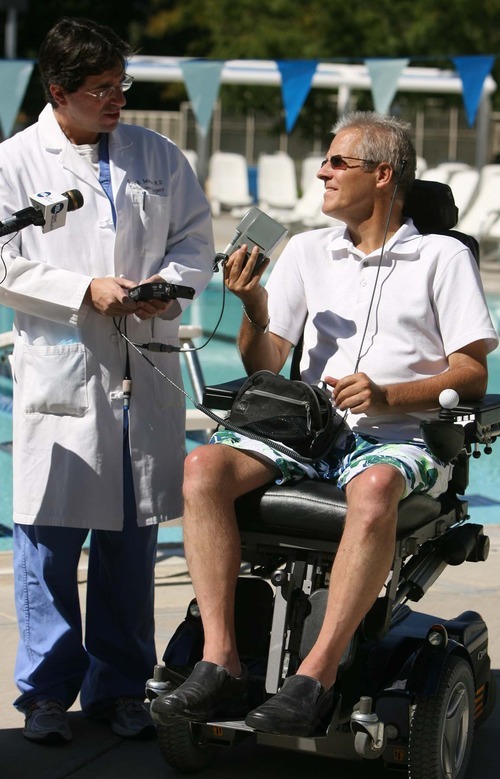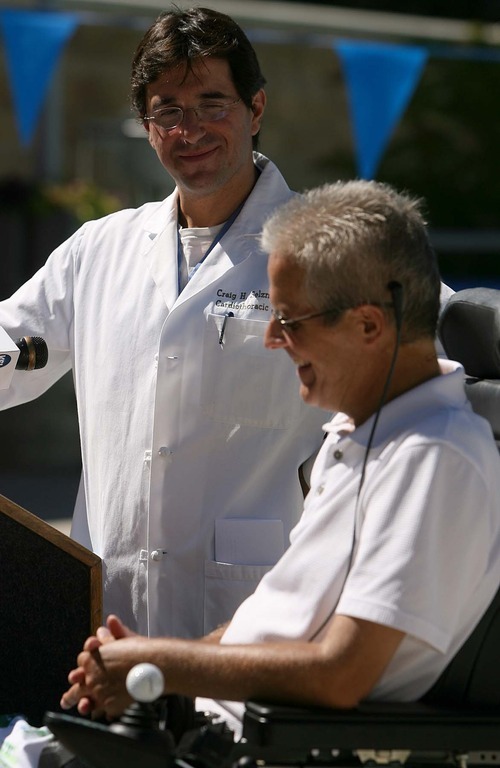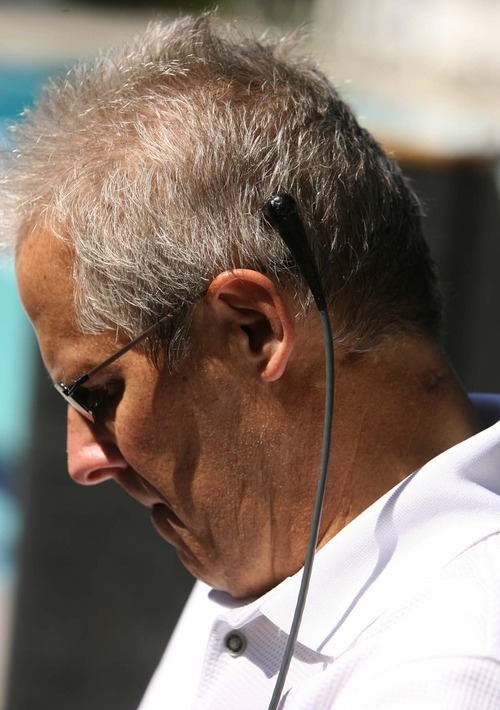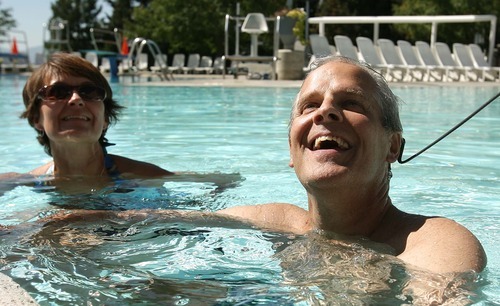This is an archived article that was published on sltrib.com in 2011, and information in the article may be outdated. It is provided only for personal research purposes and may not be reprinted.
Bill Boren can swim again, thanks to a surgery new to North America.
On Thursday, with the help of his physical therapist, he did a frog-style backstroke and some water aerobics under a beautiful summer sky at the IJ and Jeanné Wagner Jewish Community Center pool in Salt Lake City, a remarkable feat for a 54-year-old man with an artificial heart pump that needs an external power source.
"It feels good," he said, turning his face to catch afternoon rays. "It's a natural high."
The Utah father of four has a type of muscular dystrophy that mostly affects the large muscles in his legs, shoulders and heart. Muscular dystrophy is a group of hereditary and non-hereditary diseases that weaken the musculoskeletal system.
During the 30 years of his illness, Boren's heart gradually lost its ability to squeeze more than 15 percent of his blood from his left ventricle to his body. Craig Selzman, surgical director of the University of Utah's heart transplant program, said a healthy adult heart pumps about 65 percent of the body's blood per beat.
Boren was too sick for a heart transplant. So his surgeons recommended an artificial heart pump called a left ventricular assist device, or LVAD, be implanted in his chest.
Now, Boren has what his medical team calls a waterproof heart.
Selzman knew that in Europe, surgeons had implanted around 80 LVADs whose battery packs were attached to a port created behind the patient's left ear. Because Boren was a swimmer, and because exercise is vital for a healthy body and mind, the U. pushed for and received special permission from the U.S. Food and Drug Administration — which hasn't yet approved this approach — to do the surgery the European way, which his insurance covered.
The U., a pioneer in heart-transplant medicine, has implanted about 1,100 LVADS in patients. The one in Boren's heart was invented by Robert Jarvik, who received his medical degree from the U. in 1976 and whose Jarvik 7 artificial heart in 1982 was implanted in retired dentist Barney Clark, who lived 112 days after the surgery.
The Jarvik LVAD is about the size of a D battery, looks like a silver bullet and contains a spinning rotor. It is sewn into a patient's left ventricle. A woven Gore-Tex tube provides a conduit for blood to the aorta — the largest artery in the body. Also attached to the bullet are plastic-encased wires.
Ordinarily, the LVAD wires are threaded through a surgically created opening in the patient's abdomen and connected to the power source, and cannot get wet. In Boren's case, Selzman said, the wires were threaded from his ventricle under the skin of his chest and scalp to a steel platform surgeons anchored inside his skull behind his left ear. The platform has a water-impervious port similar to those in common electronic devices that need recharging. The port is where Boren plugs in his battery, whose controls can be adjusted according to his heart's needs.
To demonstrate his new water-friendly device, Boren and his physical therapist, Lisa Carter, eased into the pool using a submersible wheelchair. Once in, he rolled on his back, his head partway under water, and swam while a nurse walked along the edge of the pool holding the battery pack. He followed the swim with pool aerobics designed to strengthen the anti-gravity muscles his disease has sapped.
Boren's swim was his sixth since his long recovery from the March surgery. "I'm improving every time," he said, though it takes him a day to recover from a one-hour session.
The Jewish Community Center gave Boren a membership so he could use their outdoor pool, and the center is having a lift installed in the indoor pool so he can keep working out when the weather turns.
Before he got in the water, Boren said he used to swim 30 minutes a day, five days a week. He previously had a defibrillator implanted to shock his heart into action and was on medication to counter his muscular dystrophy, but he was deteriorating.
Though difficult, the LVAD surgery saved his life. "I wouldn't be here today if I [hadn't] had this surgery done," he said. "I'd be long gone."
Boren hopes his pool therapy can help him walk again. He still gets a little nervous when he has to unplug to change out his battery, he said. But he can shower, and he doesn't have to change bandages or risk infection as he would if the power connection were in his soft abdominal tissue.
"Just taking a shower made my quality of life better," he said. "I love life. ... I'm just lucky."
Blinking back tears, Boren thanked Selzman and the others who convinced him to go through with the surgery. "I thought I owed it to myself and my family to try to keep myself alive," he said. "I am grateful. There are days when I wake up and [say], 'Man, I'm hooked to a battery.' It's just amazing." —
What's an LVAD?
A left ventricular assist device, or LVAD, is a battery-operated mechanical device surgically implanted in a patient to help a malfunctioning heart keep beating. Sometimes called a "bridge to transplant," an LVAD helps buy time for people waiting for heart transplants. More recently, LVADs have been used longer term as part of "destination therapy" for heart-failure patients who don't have the option of a transplant.
In most cases, plastic-encased wires attached to the pump are brought through the abdominal wall to the outside of the body and attached to the pump's battery and control system. But for the first time in North America, surgeons at the University of Utah have tunneled the wires under a patient's chest skin and scalp to attach to a port in the skull behind the left ear.















